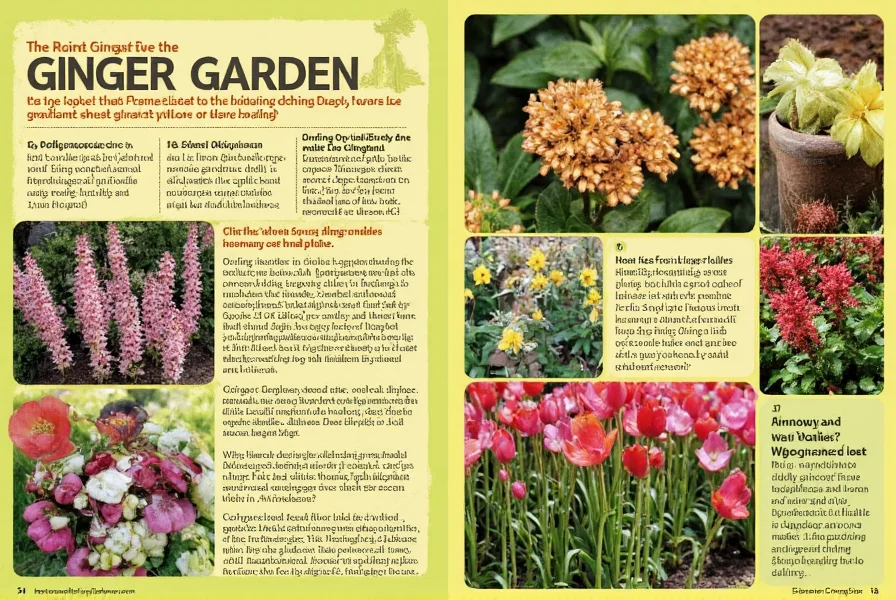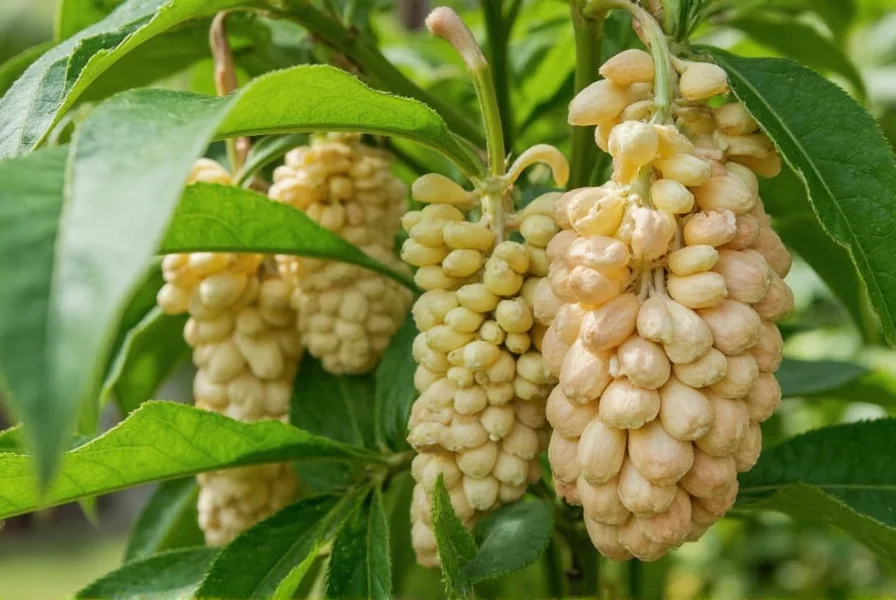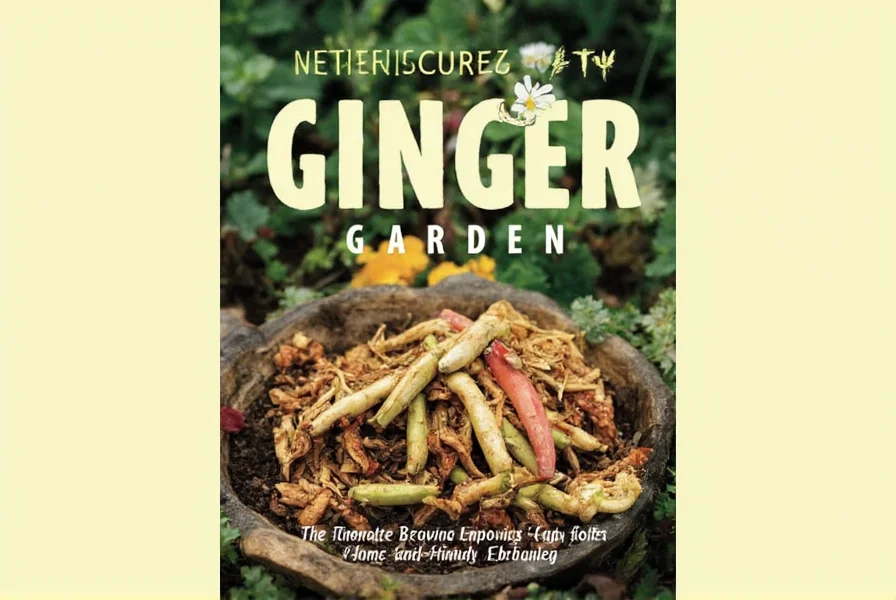Growing your own ginger garden offers fresh, organic rhizomes for culinary and medicinal use while adding tropical beauty to your outdoor space. This comprehensive guide provides science-backed techniques for cultivating healthy ginger plants regardless of your gardening experience level.
Understanding Ginger Varieties for Home Gardens
Not all ginger varieties perform equally well in home garden settings. Common ginger (Zingiber officinale) remains the most popular choice for culinary use, while galangal and torch ginger offer unique flavors for specialized cooking. When selecting ginger rhizomes for planting, choose plump, firm pieces with multiple 'eyes' or growth buds. Organic grocery store ginger often works well for propagation, though specialized gardening suppliers provide disease-resistant cultivars optimized for home cultivation.

Optimal Soil Conditions for Ginger Cultivation
Ginger requires specific soil conditions to thrive. The ideal soil composition includes:
| Soil Component | Recommended Percentage | Function |
|---|---|---|
| Organic compost | 40% | Provides nutrients and improves moisture retention |
| Well-rotted manure | 20% | Enhances soil fertility and structure |
| Perlite or sand | 20% | Ensures proper drainage to prevent rhizome rot |
| Garden soil | 20% | Provides mineral content and stability |
Maintain a slightly acidic to neutral pH between 5.5 and 6.5. Test your soil before planting and amend accordingly using sulfur to lower pH or lime to raise it. Proper soil preparation represents the most critical factor in successful ginger garden establishment and long-term productivity.
Step-by-Step Ginger Planting Guide
Follow these precise steps for optimal ginger planting success:
- Prepare rhizomes: Soak store-bought or saved ginger rhizomes in warm water for 2-4 hours before planting to stimulate growth
- Cut sections: Divide rhizomes into 1-2 inch pieces, each containing at least one growth bud
- Planting depth: Position rhizomes with growth buds facing upward, 2-4 inches below soil surface
- Spacing: Allow 8-12 inches between plants and 18-24 inches between rows
- Initial watering: Moisten soil thoroughly after planting, then wait until top inch dries before watering again
For container gardening, select pots at least 12 inches deep with adequate drainage holes. Use the same soil mixture as for in-ground planting. Container-grown ginger requires more frequent watering but offers the advantage of mobility to optimize light and temperature conditions.
Essential Care Practices for Healthy Ginger Plants
Proper care throughout the growing season ensures robust ginger plant development. Monitor these critical factors:
Watering Requirements
Ginger needs consistent moisture but cannot tolerate waterlogged conditions. During active growth (spring through summer), water when the top inch of soil feels dry. Reduce watering in fall as plants prepare for dormancy. In regions with heavy rainfall, consider raised beds to prevent water accumulation around rhizomes.
Light Exposure
Ginger thrives in dappled sunlight or partial shade, receiving 2-5 hours of morning sun with protection from intense afternoon rays. In cooler climates, provide more sun exposure; in hotter zones, increase shade coverage. Container gardeners can optimize light conditions by moving plants throughout the day.
Fertilization Schedule
Feed ginger plants every 4-6 weeks during the growing season with balanced organic fertilizer (5-5-5 NPK). Alternatively, side-dress with well-rotted compost. Avoid high-nitrogen fertilizers that promote excessive leaf growth at the expense of rhizome development.

Common Ginger Garden Challenges and Solutions
Even with proper care, ginger garden problems may arise. Address these common issues promptly:
- Yellowing leaves: Usually indicates overwatering. Reduce watering frequency and improve soil drainage
- Leaf spot diseases: Remove affected leaves and apply organic copper fungicide
- Rhizome rot: Caused by poor drainage; improve soil structure and avoid overhead watering
- Spider mites: Increase humidity and spray with insecticidal soap solution
- Slow growth: May indicate insufficient nutrients; apply balanced fertilizer
Preventative measures work best for maintaining healthy ginger plants. Rotate planting locations every 3-4 years to prevent soil-borne disease buildup, and practice good sanitation by removing plant debris at season's end.
Harvesting and Storing Your Ginger Crop
Timing your ginger harvest correctly ensures maximum flavor and yield. Most varieties reach maturity 8-10 months after planting, when foliage begins to yellow and die back naturally. To harvest:
- Reduce watering 2-3 weeks before harvest to dry the soil slightly
- Carefully dig around plants with a garden fork to avoid damaging rhizomes
- Lift entire plants from the soil
- Shake off excess soil (do not wash)
- Cut stems 1-2 inches above rhizomes
- Cure in a warm, dry, shaded location for 3-7 days
Store cured ginger in a cool, dark place with good air circulation. Properly stored rhizomes remain viable for 2-3 weeks at room temperature or 4-6 weeks refrigerated in a paper bag. For longer storage, freeze peeled ginger or preserve in vinegar.
Extending Your Ginger Growing Season
Gardeners in cooler climates can successfully grow ginger by implementing these strategies:
- Start ginger indoors 6-8 weeks before last frost date
- Use black plastic mulch to warm soil in spring
- Grow in containers that can move indoors when temperatures drop below 50°F (10°C)
- Provide frost protection with row covers when temperatures approach freezing
- Choose faster-maturing varieties like 'Baja Gold' for shorter growing seasons
Container gardening represents the most flexible approach for gardeners outside USDA zones 9-12. Bring containers indoors before first frost and place near a bright window or under grow lights for continued growth through winter months.
Frequently Asked Questions
Can I grow ginger from grocery store rhizomes?
Yes, organic grocery store ginger often works well for home cultivation. Look for plump rhizomes with visible growth buds (eyes). Soak in warm water for a few hours before planting to stimulate growth. Note that conventionally grown ginger may have been treated with growth inhibitors, so organic is preferable for propagation.
How long does it take to grow ginger to harvest?
Ginger requires 8-10 months of warm growing conditions to produce harvestable rhizomes. You'll know ginger is ready when the leaves begin to yellow and die back naturally, typically in late fall. For 'baby ginger' with thinner skin and milder flavor, you can harvest earlier at 4-6 months.
Why are my ginger plant leaves turning yellow?
Yellowing leaves typically indicate overwatering or poor drainage. Ginger needs consistently moist but not waterlogged soil. Check your soil drainage and reduce watering frequency. If yellowing occurs in fall, it may signal natural dormancy as the plant prepares for harvest. Nutrient deficiencies can also cause yellowing, so ensure proper fertilization throughout the growing season.
Can ginger plants survive winter outdoors?
Ginger cannot survive freezing temperatures. In USDA zones 9-12, mulch heavily (6-8 inches) to protect rhizomes through mild winters. In cooler zones, dig up rhizomes before first frost and store indoors, or grow in containers that can be brought inside. Container-grown ginger can continue growing indoors near a bright window when temperatures drop below 50°F (10°C).
How do I prevent ginger rhizomes from rotting?
Prevent rhizome rot by ensuring excellent soil drainage. Use a soil mixture with 20% perlite or sand, and consider raised beds in areas with heavy rainfall. Avoid overwatering, especially as plants approach dormancy. Never waterlogged conditions, and reduce watering frequency when foliage begins to yellow. Proper spacing (8-12 inches between plants) also improves air circulation and reduces moisture-related problems.











 浙公网安备
33010002000092号
浙公网安备
33010002000092号 浙B2-20120091-4
浙B2-20120091-4